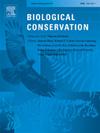Identifying Conservation Priority Areas of China: A methodological framework for ecosystem integrity and authenticity
IF 4.9
1区 环境科学与生态学
Q1 BIODIVERSITY CONSERVATION
引用次数: 0
Abstract
The protection and restoration of ecosystems are recognized as a crucial component of the global nature conservation and are essential to sustainable development worldwide. Ecosystem integrity and authenticity can well reflect the degree of stability of ecosystem structure, function and process, as well as the ability to resist disturbance, and have therefore become the core indicators in ecosystem assessment. However, no scientific and universal assessment method has been developed yet. In this study, we proposed a methodological framework for ecosystem integrity and authenticity assessment based on multiple dimensions including landscape, vegetation and wildlife, comprising 3 perspectives and 6 indicators. We have constructed a comprehensive index of key protection value, exploring the spatial heterogeneity of ecosystem integrity and authenticity for the first time, and selected China as a case study. The results indicate that the ecosystems of the Greater and Lesser Khingan Mountains, Changbai Mountains, Qinghai-Tibet Plateau, Hengduan Mountains, and some parts of the Zhejiang-Fujian hilly areas possess high key protection values. We have delineated conservation priority areas with the goal of protecting over 30 % of the national territory, and identified 70 regions with high conservation values among them that balance ecosystem typicality and representativeness, providing a basis for the next stage of national park construction in China. Linking ecosystem protection with the construction of protected areas, this methodological framework may serve as a useful paradigm for measuring the conservation value of natural ecosystems in countries worldwide.
求助全文
约1分钟内获得全文
求助全文
来源期刊

Biological Conservation
环境科学-环境科学
CiteScore
10.20
自引率
3.40%
发文量
295
审稿时长
61 days
期刊介绍:
Biological Conservation is an international leading journal in the discipline of conservation biology. The journal publishes articles spanning a diverse range of fields that contribute to the biological, sociological, and economic dimensions of conservation and natural resource management. The primary aim of Biological Conservation is the publication of high-quality papers that advance the science and practice of conservation, or which demonstrate the application of conservation principles for natural resource management and policy. Therefore it will be of interest to a broad international readership.
 求助内容:
求助内容: 应助结果提醒方式:
应助结果提醒方式:


